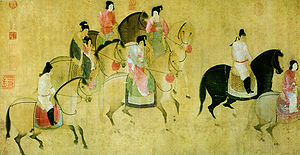


During the Tang dynasty, as a golden age in Chinese civilization, Chinese painting developed dramatically, both in subject matter and technique.The advancements in depth, technique, style, intricacy, complexity, and sophistication that characterized the paintings of the Tang era had an everlasting influence influence on Central and East Asian art.
A considerable amount of literary and documentary information about Tang painting has survived, but very few works, especially of the highest quality. A walled-up cave in the Mogao Caves complex at Dunhuang was discovered by Sir Aurel Stein, which contained a vast haul, mostly of Buddhist writings, but also some banners and paintings, making much the largest group of paintings on silk to survive. These are now in the British Museum and elsewhere. They are not of court quality, but show a variety of styles, including those with influences from further west. As with sculpture, other survivals showing Tang style are in Japan, though the most important, at Nara, was very largely destroyed in a fire in 1949.[1]
The rock-cut cave complexes and royal tombs also contain many wall-paintings. Court painting mostly survives in what are certainly or arguably copies from much later, though the front section of the famous portrait of the Emperor Xuanzong's horse Night-Shining White is probably an original by Han Kan of 740-760.[2]
The Tang dynasty saw the maturity of the landscape painting tradition known as shanshui (mountain-water) painting, which became the most prestigious type of Chinese painting, especially when practiced by amateur scholar-official or "literati" painters in ink-wash painting. In these landscapes, usually monochromatic and sparse, the purpose was not to reproduce exactly the appearance of nature but rather to grasp an emotion or atmosphere so as to catch the "rhythm" of nature. The long-lasting tradition of the Southern School began in this period.[3]